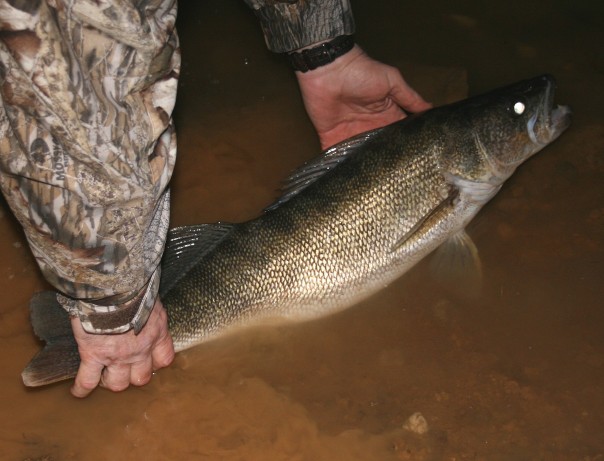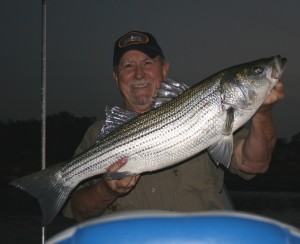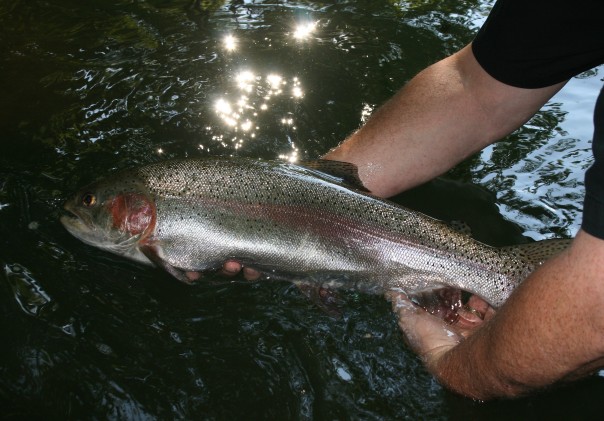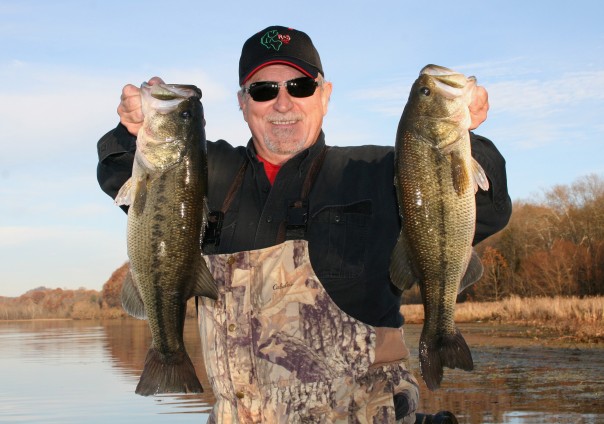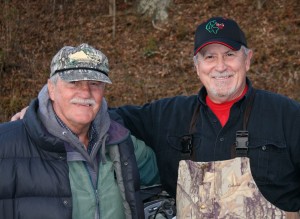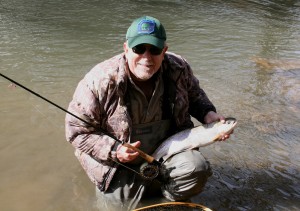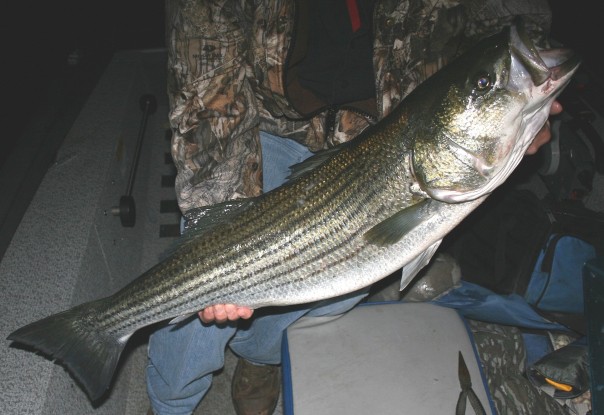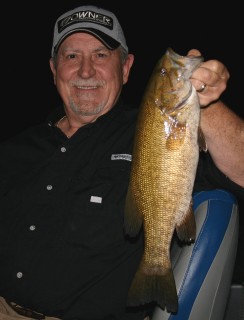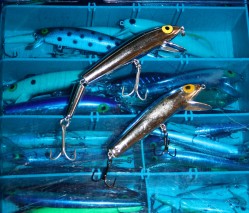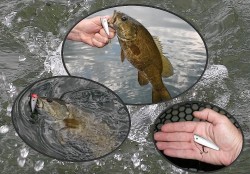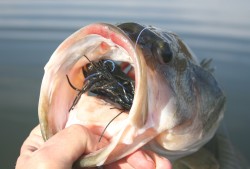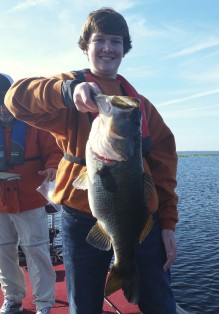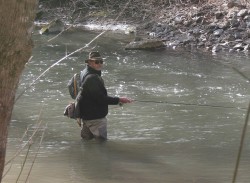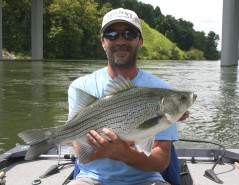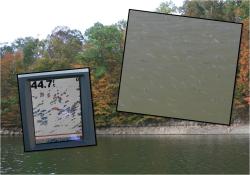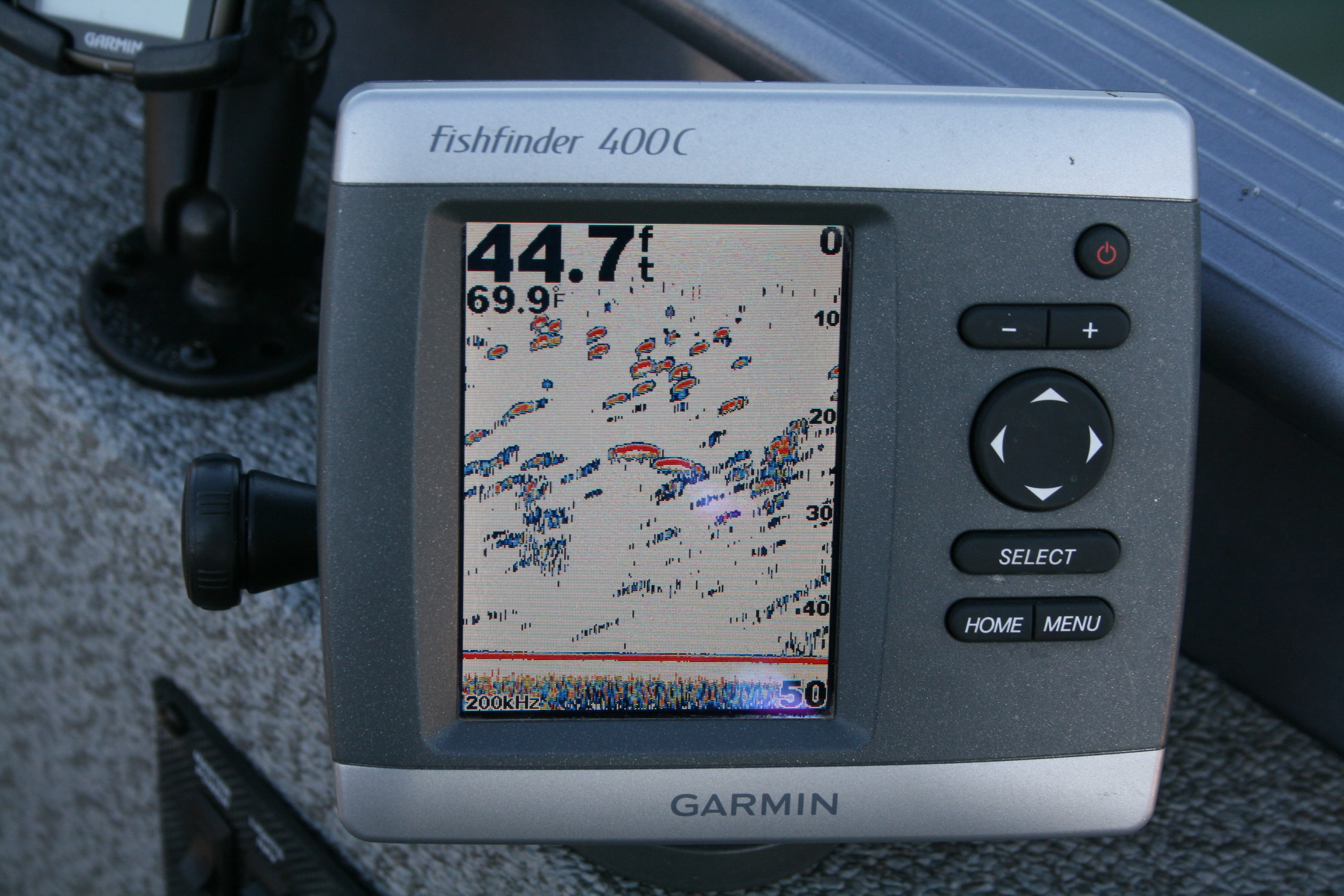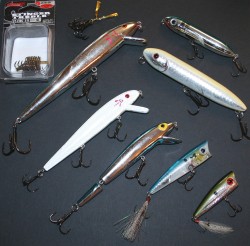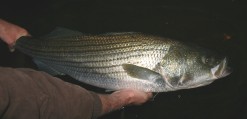Back On The Water!
It’s been much too long since last posting material on my blog but there’s a reasonably good excuse for it. In February 2016, I had rotator-cuff surgery on my right shoulder for the second time. The same surgeon who repaired my shoulder in 2011 told me to expect about an 85% recovery, meaning use of my right arm. He also assured me that fishing as in the past would not be part of my future. Serious limitations would have to be set and accepted. After that prognosis, learning to fish left-handed was added to my to-do list.
From late 2015 until my scheduled surgery date in mid-February, boredom ruled an endless series of days that revolved around resting my shoulder; the goal to minimize inflammation of tissue before surgery. That’s easier said than done because I don’t do “coach potato” well at all. While pacing the floor twelve days before surgery, a pause in turn 6 found me staring out a window. It was a beautiful sunny day with a light breeze and temperatures well above normal. Claustrophobic and depressed, a beam of sunlight suddenly struck me and the idea of running to a local river to practice left-handed casting came to mind. A quick analysis of pros and cons confirmed that learning to fish left-handed was an important part of my recovery plan and something that could begin before surgery. Also, free time was available in profusion. So, with an upbeat attitude, away I went. In hindsight, more thought should have been given to the cons.
After arriving at a river full of smallmouth bass and tying on a Texas-rigged soft plastic, casting practice began. The first few attempts were at weeds and sticks on open ground away from trees; a wise starting point. It’s shocking how difficult it is for a righty to make a simple left-handed lob-cast. But with practice my lure was soon hitting the river, and at times close to the intended spot. In perhaps a dozen casts, I felt a light tap through the line, reeled down and set the hook. The force of the hook-set, an equally awkward movement left-handed, pulled a nice smallmouth to the surface where it immediately threw the lure. In response, I turned and stepped in a muskrat hole all the way to my left knee-cap. While falling in slow-motion, all concern shifted to my shoulder so rather than trying to catch myself, I attempted rolling toward my good shoulder. The next morning after draining 70 cc’s of blood off my left knee, an x-ray showed no visible breaks or tears so an elastic knee brace was added to my post-op equipment list.
After two months of recovery from surgery and plenty of physical therapy, my routine at home had returned to staring at the walls and laps through the house. Soon lap times were approaching those before surgery, except a few of the more hazardous turns where I didn’t want to press the damaged knee. After consulting my best fishing buddy, we decided it was time for me to get out on the water but with some serious restrictions. We agreed that trolling for brown and rainbow trout was a good choice because I could sit and stare as easily as at home and would get some fresh air and sunshine in the process. My attitude improved after discovering I could operate the landing net left-handed with little difficulty. After a fish or two, it was game on!
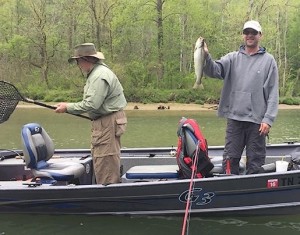
My first trip afield, two months after surgery. Couldn’t operate the boat or a fishing rod but enjoyed netting some nice brown and rainbow trout.
We caught some beautiful trout that day up to twenty-three inches long and the therapeutic value was beyond measure. On a follow-up trip, several attempts at casting with ultralight tackle confirmed it was too much movement, even casting left-handed, so the decision was made to do only what my body would comfortably permit; with patience, careful patience.
Four months after surgery, progress permitted me to use light-weight spinning tackle for short periods. Over time, growing confidence pressed me to search for fish that would test my strength; time to try some night-fishing for reservoir smallmouth bass. During a couple short trips, the number of casts was low but several nice smallies accepted my offering and fought like champions. Landing them boosted my confidence but again made me realize it was still a long way to full recovery. A month later, an MRI was ordered to see why the knee was still bothering me. My surgeon, obviously bug-eyed with disbelief, slowly walked into the room staring at my MRI results, which had been delivered by yours truly minutes before. “About that knee, we have a fracture,” he announced after a long pause. His review described a hairline fracture across the largest bone in my knee that had not shown up on the post-accident X-ray. Yep, I had broken it. He closed by telling me no further treatment of the knee would be necessary, other than some simple exercises, because it was healing nicely. He closed in saying, “This is a testament to how tough you are.” He must have said that because of my work schedule at Bass Pro Shop in the months before my MRI. Who would have guessed?
The arrival of fall found me much more active. My right shoulder was still weak and tender with limited range-of-motion but casting left-handed had become almost routine. Days after beginning some new stretching exercises, the broken knee was forgotten. I was strong and mobile enough that launching the boat was no problem and could fish for about an hour before having to rest my right arm. After a cool snap brought the first freezing temps of the season, a search for schooling striped and hybrid bass began. Fishing for surface-schooling fish is a mixture of much driving around, setting and watching for fish breaking and casting for short periods; an almost perfect match considering my limitations. With a selection of rods rigged with favorite fall striper/hybrid lures, the adventure began one sunny afternoon. Surface water temperature was ideal, in the mid-60’s, and confidence was high. After a long search, clouds of baitfish began appearing on the depth finder in a long narrow cove that ran inland off the main lake. The narrow strip of water didn’t look like much when driving by but an expanded search found it full of baitfish with water depths exceeding forty-feet along much of its surprising length. After confirming it was full of striper food, I moved back where I could see the main lake and much of the cove. It was time to drop the trolling motor, set back and wait.
An hour later the water erupted on the main lake close to the mouth of the cove. Big fish were smashing schools of baitfish not more than a hundred yards away so I moved quickly toward them. Soon there were fish smashing the surface in every direction. Then a jointed Storm ThunderStick landed among the explosions and began making a V-wake along the surface, then a seven-inch Cordell Red Fin, then a large swimbait fluttered along a few feet beneath the surface, all without so much as a bump. Round two with the ThunderStick included variations in speed until, finally, a boil rose beneath the plug. But that was my only strike after more than an hour of casting to feeding fish. Minutes later the water went flat and calm; the party was over and the fish were gone. My mind was sorting through possible reasons for the lack of success when a crippled minnow fluttered by along the surface. The minnow’s size surprised me because it was much smaller than expected. After slowly approaching several schools of surfacing minnows for further size checks, my suspicions were confirmed. My lure choices were too large.
The next day found me waiting in the same spot but with smaller lures rigged. My primary rod held a modified version of the plug that had produced the boil; a Storm ThunderStick. The modified version had the rear section removed with the split ring and hook reattached to the front. With this simple change, the lure’s length was reduced from more than five-inches to four with no change in the plug’s action. Back up combos included a smaller swimbait and a Rat-L-Trap. Soon after arriving a good fish boiled the surface close by, then another. Suddenly, an area the size of a parking lot was filled with watery explosions.
Almost immediately a fish attacked my modified ThunderStick and after a brief battle, a three-pound hybrid was in the net. After a quick release, the ThunderStick again sailed into the melee. On the next cast a big fish crushed the plug and pulled a deep bend in my rod. There was no question it was a much larger fish because it ripped line freely from the reel and forced me into a defensive squat. After several line-stripping runs, the fish finally surfaced close to the boat; a striped bass in the mid-teens. At boat-side, a firm grip on the fish’s jaw was shaken off as if attempted by a child. I could grab the fish well enough but any attempt to lift made me realize how weak my arm was. The idea of shifting the rod to my right hand was rejected quickly after the fish surged; there was no way my right arm could take that. After remembering a gaff stowed in the rear of the boat, the fish was safely landed and released unharmed, save a small hole in its lower lip. In the time taken to land the fish, snap a couple pictures and release it, the surrounding school of feeding fish disappeared and the water became still. It felt like the end of a standing ovation as the last few tail slaps subsided in the background; a rewarding afternoon. In the best of moods, a decision was made to add a new Boga Grip to my fishing tool box.
Work and book signings kept me busy through the Holidays but by mid-January fishing fever returned. Thoughts of visiting a highland reservoir for bass crossed my mind but required a significant investment of time and exposure to some very cold conditions. So, brief trips to pitch soft-plastics from shore to river smallies moved to the top of my schedule. But one day, a friend and coworker at Bass Pro Shop told me about a pattern for catching big walleyes during the coldest period of winter. Walleyes spawn in late winter/very early spring in the south and many instinctively migrate into moving water as the time to drop eggs approaches. Areas with increased current attract pre-spawn walleyes and those that hold abundant prey such as alewives, shad, even trout, may attract many of the largest walleyes in the system. The pattern my friend described required fishing a local reservoir from shore at night during the coldest part of winter when the lake water level was at its lowest. The low water period lasted but a brief time, while at winter pool, and wasn’t about how many fish you could catch but how big the fish were. I had to sign up for some of that.
My first trip to fish at night for winter walleyes was more about exploration than serious fishing. Learning details like water depth, temperature, bottom contour and structure present would help me decide which lures would work best. Casting hazards and required distance would dictate the rod and reel combo needed for precise presentations. After exploring and casting for an hour I decided an adjustment in equipment would permit me to fish the area well with a large swimbait, one of the lure’s my friend recommended. Several days later we returned with a third fishing buddy and spread along a sand-covered shoreline that gradually sloped from the water’s edge to a meandering creek channel. In many places, a long cast would reach the channel’s edge. In some spots, there were trees lying across the barren shore with their tops partially submerged in shallow water. Soon we were spread along several hundred yards of shoreline, casting from parallel to shore, out to along the edge of the channel break. In fewer than thirty-minutes, as my swimbait tapped along bottom in the shallows, the water boiled and my line became tight with a heavy, head-shaking fish. 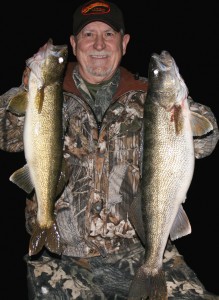 Minutes later the glowing eyes of a big walleye surfaced against shore as one of my fishing buds arrived carrying another fish. A break to check size revealed his walleye weighed four-pounds; a nice fish and average size for the lake we were fishing. Mine was a hog weighing eight-and-three-quarter-pounds and stretching twenty-seven-and-a-half inches. A week or so later another trip rewarded me with a twenty-seven-and-three-quarter inch walleye that looked a little fatter, though I didn’t take time to weigh her before release. Soon after, spring rains arrived much too early and the lake began rising quickly. I’ll be back to visit those fish again after the next Christmas Holiday passes.
Minutes later the glowing eyes of a big walleye surfaced against shore as one of my fishing buds arrived carrying another fish. A break to check size revealed his walleye weighed four-pounds; a nice fish and average size for the lake we were fishing. Mine was a hog weighing eight-and-three-quarter-pounds and stretching twenty-seven-and-a-half inches. A week or so later another trip rewarded me with a twenty-seven-and-three-quarter inch walleye that looked a little fatter, though I didn’t take time to weigh her before release. Soon after, spring rains arrived much too early and the lake began rising quickly. I’ll be back to visit those fish again after the next Christmas Holiday passes.
So, I have finally returned to the fold, so to speak. Fishing and writing are again part of my routine though use of my right arm is still limited. In support of my continuing recovery, trolling will be included in much of my future fishing; rainbow trout, crappie, walleye and others come to mind. Another angling method I’ll employ frequently is presenting live or dead baits on set lines. Big carp, striped bass and catfish are suckers for the right baits presented on bottom. Both approaches will permit me to fish with limited stress on my shoulder while I strengthen it further. However, occasional trips to enjoy long-standing-favorites such as night fishing for summer smallmouths and the fall topwater blitz will be made; left handed of course. Visit me here to read updates on my progress and angling adventures, including new things I learn.
In closing, it is with great sadness that I bring readers news from R&S Bait Company. In late May of 2015, our sport lost a rising star when Rodney Williams, owner of R&S Baits, lost his battle with cancer. Now, his family has no plans to continue operation of the company and the R&S Web site has been closed. Such a loss; a dear friend and talented contributor to our sport. To provide some history about my friendship with Rodney Williams, there’s a story in my book about fishing small jigs for summer smallmouths at night using black lights, though at the time my book was published I didn’t know R&S Bait Company manufactured the jigs described. A story posted on this Blog about meeting and becoming friends with Rodney Williams attracts a lot of traffic and many readers inquire about availability of R&S Baits’ products. If you’d like to read the story behind the story of how we met and became friends, find the Archives button at the top right of this page, click Select Category, then select Announcements and you’ll find a story called “From My Friends at R&S Bait Company”. To read a story about night fishing with R&S Baits Arky Smallmouth Jigs, select Summer Fishing and scroll down to a story called “Day and Night Summer Smallmouth Bass”. To see the side bar photos from each story, click Enlarged Side Bar Photos at the top and select the story title.
It’s good to be back. Be safe and good fishing!
Adapting to Changing Conditions
After turning the page on my office calendar to August, I paused to reflect on where the time had gone. Notes on the last few pages confirm each month was a whirlwind of activity, mostly of the non-fishing variety. Not that there wasn’t some time to fish, but much of my spring and early summer seasons were filled with other time-consuming activities; more on that later. Furthermore, favored places to fish were limited this year. Another hot, dry spring reduced flow on local rivers so much that productive fishing for smallmouth bass was affected and repairs at a local dam transformed some of my favorite spring fishing waters so completely I was forced to search for new ones. Nonetheless, the search for good fishing led to the discovery of new opportunities and limited choices encouraged me to invest more time in spring patterns still available. The extra time spent pursing two of my favorite game fish, rainbow and brown trout, produced an exceptional season of spring and early-summer trout fishing.
I learned to fish for trout long ago, limited then to fishing small mountain streams and stock ponds for freshly stocked fish. Many years later after moving to Tennessee, my focus changed to catching holdover tail-water trout; those that had lived for years on a diet of abundant natural prey in cool, swift water. This spring has been a testament to what I’ve learned about fishing for larger tail-water trout. We caught many rainbows and browns above eighteen inches but some special fish and one exceptional encounter come to mind. My most memorable tail-water trout adventure so far in 2015 included my best fishing buddy Andy and his 12-year old son, Harrison. Harrison had already proved he could catch trout by trolling for them. On his best outing he was credited with catching twenty-eight rainbows, though Andy and I reeled in a few of them because we had several doubles hookups. However, this trip was Harrison’s first to cast for them so when we arrived on good water, casting practice began. Andy helped with the casting part but each time the lure hit the water, Harrison took control of the rod and the retrieve. Soon we were coaching him on ways he could vary his presentation by changing speed, pausing or adding subtle twitches.
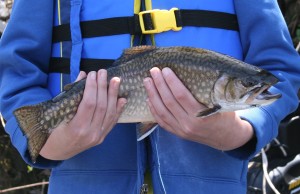 Not long into our second drift, Harrison’s rod bowed deeply and a big trout thrashed the surface. With a firm grip on his rod, he fought the big fish well while Andy coached and I controlled the boat in swift water. When Andy slipped the net under the struggling fish, shouts of victory filled the air. It wasn’t just a big trout; it was a huge brook trout. For those of you not familiar with brook trout, let me put the size of this fish in perspective. In the State of Tennessee, if you catch a brookie ten-inches or longer, the Tennessee Wildlife Resources Agency will award you with a colorful Trophy Fish Award, suitable for framing. The brook trout Harrison landed was sixteen-inches long. Before the day was over, he also landed a rainbow and brown trout above eighteen-inches. So on his first trip casting for them, Harrison landed the Eastern equivalent of the trout trifecta and did so with some remarkably nice fish.
Not long into our second drift, Harrison’s rod bowed deeply and a big trout thrashed the surface. With a firm grip on his rod, he fought the big fish well while Andy coached and I controlled the boat in swift water. When Andy slipped the net under the struggling fish, shouts of victory filled the air. It wasn’t just a big trout; it was a huge brook trout. For those of you not familiar with brook trout, let me put the size of this fish in perspective. In the State of Tennessee, if you catch a brookie ten-inches or longer, the Tennessee Wildlife Resources Agency will award you with a colorful Trophy Fish Award, suitable for framing. The brook trout Harrison landed was sixteen-inches long. Before the day was over, he also landed a rainbow and brown trout above eighteen-inches. So on his first trip casting for them, Harrison landed the Eastern equivalent of the trout trifecta and did so with some remarkably nice fish.
My most exciting fishing experience this season came on a day when time to fish was limited. With but a few hours free and no fishing partner, I loaded my boat and headed for the closest tail-water. Local weather and water generation schedules were favorable for trout fishing, though it was midday under a sunny, blue sky. After making the first drift through prime water without so much as a follow, I changed to a larger lure, returned to my starting point and began again. A few casts into the second drift a big fish smashed my plug hard and began stripping line. The fish moved so fast and with such power, I was sure it was a big hybrid and quickly realized my hands were full.
I was adrift in fast water and approaching a shoal so shallow that hitting rocks with the trolling motor prop was a probability, but didn’t want to raise the motor and let the boat spin during the fight. With one hand on the trolling motor and the other controlling the surging fish, it became a very busy time. If I had a third hand, I’m sure it would have been equally busy. Suddenly, the fish charged the boat and did its best to tangle my line in the outboard. After a few tense seconds, it came free from the lower unit as the river bottom came up along the upstream face of the shoal. Then, out the corner of my eye I saw the big fish jump clear of the water. Even in my adrenalin-filled state I realized that hybrids don’t jump so my eyes 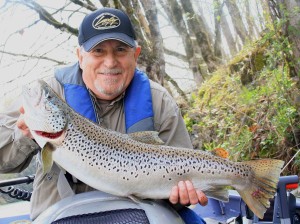 strained for a clear view of my adversary as it approached the boat, then in less than two-feet of water. As we drifted over the shoal, the big fish swam closer and was soon swimming parallel to the boat in water so shallow it could clearly be seen. The light-brown color and big spots along the fish’s back confirmed it was a huge brown trout. After drifting into deeper water, it became a battle of patience and the big fish was in trouble. Finally, I led her into the net and lifted my largest brown trout ever into the boat; a beautifully marked twenty-nine-inch female. There was little time to set up and take pictures because my greatest concern was for the fish’s health. But after a few quick shots and gentle handling beside the boat, she recovered, surged from my grip and disappearing into the rushing water. I collapsed in my seat, took several deep breaths and talked to myself until my heart-rate slowed. Drained after the battle, I set out trolling rods and trolled back to the ramp. Several smaller fish up to sixteen inches came to the net on the relaxing cruise back that sunny afternoon. It was a brief though memorable outing and invigorating dose of outdoor therapy; one to remember for a very long time.
strained for a clear view of my adversary as it approached the boat, then in less than two-feet of water. As we drifted over the shoal, the big fish swam closer and was soon swimming parallel to the boat in water so shallow it could clearly be seen. The light-brown color and big spots along the fish’s back confirmed it was a huge brown trout. After drifting into deeper water, it became a battle of patience and the big fish was in trouble. Finally, I led her into the net and lifted my largest brown trout ever into the boat; a beautifully marked twenty-nine-inch female. There was little time to set up and take pictures because my greatest concern was for the fish’s health. But after a few quick shots and gentle handling beside the boat, she recovered, surged from my grip and disappearing into the rushing water. I collapsed in my seat, took several deep breaths and talked to myself until my heart-rate slowed. Drained after the battle, I set out trolling rods and trolled back to the ramp. Several smaller fish up to sixteen inches came to the net on the relaxing cruise back that sunny afternoon. It was a brief though memorable outing and invigorating dose of outdoor therapy; one to remember for a very long time.
Though my time on the water this season has been limited, a few trips for other fish were also rewarding. During early spring, a couple night-fishing trips for river-run walleyes produced good results. In spring, walleyes in most southern reservoirs migrate into primary feeder-rivers to spawn. This concentrates them in sections where water depth and flow are favorable and prey species are present. Find walleyes and what they’re willing to strike and it can produce good catches of one of the best-tasting fish in fresh water. My preferred method of catching spring river-run walleyes is trolling at night so I scheduled a couple evenings free to go after them. Our priority on the first night was finding places on the river that held fish and we soon caught enough for a meal of fresh fillets. In just a few hours on the follow-up trip, under a star-studded sky, we stayed busy catching and culling fish. Repeated trolling passes along a sixty-yard stretch of water produced more than two-dozen walleyes including a few double hookups with a smallmouth bass and catfish or two mixed in. Trolling at night on a river may sound like a recipe for trouble but it’s an effective method of fishing if you follow a few simple safety rules and employ the correct lures and methods of presentation. To learn more about trolling for walleyes and other fish at night on rivers, refer to the chapter on “Winter Fishing” in my book, The Weekend Angler’s Guide To Good Fishing.
Several outings for bass produced nice catches, including both river and reservoir trips. We fished at night for reservoir largemouths when fishing pressure was lowest and smallmouths during the day on a river where only kayaks disturbed the 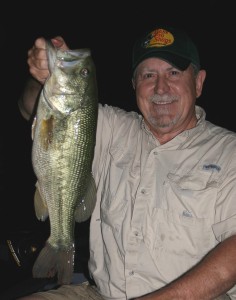 serenity. Our first bass-fishing trip of the season to search for largemouths was interesting; a rough start that bloomed into a rewarding finish. We arrived late at the ramp and had to wait in line until almost dark before launching. Then, as we prepared to take off down lake I noticed some nasty looking clouds coming our way. By the time we reached a nearby bridge for shelter, it was raining steadily. An hour later we started down the lake, one we’d not seen before, to find a place to fish in total darkness. Radar on a phone app, a depth finder and some blind luck led us to a shallow point with a distinct offshore break-line that merged with a shoreline filled with alternating layers of rock, red-clay and gravel. I was confident the diverse mixture of bottom types would attract some fish. In the next few hours we landed sixteen bass along a hundred-yard stretch, mostly smallmouths, with a five-pound, five-ounce largemouth taking top honors. Small finesse jigs with plastic pork-chunk trailers caught all our fish though we tried several soft-plastics. Regrettably, I haven’t had time to go back and fish that spot again.
serenity. Our first bass-fishing trip of the season to search for largemouths was interesting; a rough start that bloomed into a rewarding finish. We arrived late at the ramp and had to wait in line until almost dark before launching. Then, as we prepared to take off down lake I noticed some nasty looking clouds coming our way. By the time we reached a nearby bridge for shelter, it was raining steadily. An hour later we started down the lake, one we’d not seen before, to find a place to fish in total darkness. Radar on a phone app, a depth finder and some blind luck led us to a shallow point with a distinct offshore break-line that merged with a shoreline filled with alternating layers of rock, red-clay and gravel. I was confident the diverse mixture of bottom types would attract some fish. In the next few hours we landed sixteen bass along a hundred-yard stretch, mostly smallmouths, with a five-pound, five-ounce largemouth taking top honors. Small finesse jigs with plastic pork-chunk trailers caught all our fish though we tried several soft-plastics. Regrettably, I haven’t had time to go back and fish that spot again.
A few half-day trips for river smallmouths produced good fish though larger bass were less than plentiful in the low, clear conditions. The realistic action of swimbaits and soft-plastic stickbaits caught the majority of our fish with Keitech Easy Shiners and Zoom Super Flukes catching the most. Various rigging methods worked well with the Flukes when matched to water flow and natural colors were consistently good choices. However, at times four-inch swimbaits caught more fish so we had to find the best lure and method of presentation on each trip. And I often mix in some variety when fishing so we did raise a few bass on other lures. One encounter that comes to mind didn’t end with a big smallmouth photo-op, but left a vivid memory. It was a day when water generation at an upstream dam was brisk. The water level was high and moving with scattered clumps of grass drifting on the surface. However, water clarity was good and the temperature was an inviting seventy-two degrees; ideal for active river smallmouth bass. In warm moving water, fast retrieves often work well when patterning river smallies so I grabbed a spinning combo rigged with a Pop-R and began quickly covering water. No more than a dozen casts later, a bruiser smallmouth crushed the lure. I set the hook and began reeling quickly, but then my line went slack. Before I could describe what had happened and add a closing expletive, my line suddenly started streaking up river. Panicked reeling soon pulled a bow in my rod and the battle was on. However, after a hard head-shake and short burst downstream the big fish spit the lure back toward me. I thought the bass had thrown the plug because of the poor hook-set but found it had violently removed the rear treble hook, split ring and all. It was a fast and memorable tail-whipping by a big, powerful river smallmouth bass. I hesitate to estimate the fish’s size but the boil it made on the strike must have weighed four-pounds.
 So my spring and early summer excursions, though limited, included some exciting and memorable fishing. Furthermore, a recent development that kept me off the water during much of the season produced many opportunities to meet other anglers and learn more about catching fish. On April 1st, I accepted a Sales Associate position in the Fishing Department at the new Bass Pro Shop store at Exit 74 in Bristol, Tennessee. I’m working there part-time, including many weekends, and enjoying the interaction with other anglers immensely. So if your travels include a trip along the I-81 corridor through Southwest Virginia and Northeast Tennessee, take a few minutes to stop and ask for me there. I’d enjoy meeting you, swapping some fishing stories and helping you choose some lures and equipment for your next fishing adventure. Come by soon and let’s talk fishing! Hope to see you there.
So my spring and early summer excursions, though limited, included some exciting and memorable fishing. Furthermore, a recent development that kept me off the water during much of the season produced many opportunities to meet other anglers and learn more about catching fish. On April 1st, I accepted a Sales Associate position in the Fishing Department at the new Bass Pro Shop store at Exit 74 in Bristol, Tennessee. I’m working there part-time, including many weekends, and enjoying the interaction with other anglers immensely. So if your travels include a trip along the I-81 corridor through Southwest Virginia and Northeast Tennessee, take a few minutes to stop and ask for me there. I’d enjoy meeting you, swapping some fishing stories and helping you choose some lures and equipment for your next fishing adventure. Come by soon and let’s talk fishing! Hope to see you there.
Cold Water for Big Fish
It’s been too long since last posting new material on my Blog but the past few months have been extraordinarily busy. A heavy book signing schedule from Labor Day through Christmas produced high book sales and kept me on the move. I always enjoy meeting new angling friends at signing events, reliving outdoor experiences and learning things from others. However, many book signings, travel, visitors and get-togethers kept me off the water during much of autumn and the Christmas Holiday season. No complaints, because every minute spent with family and friends was enjoyable. Yet when time, weather and my schedule permitted, I reveled in some fine fishing for trout and bass. The late-fall and early-winter periods are good times to pursue big fish including our most popular game fish; largemouth bass. Fishing for the big largemouths can be rewarding during the cold-water period because fishing pressure is lowest, shallow cover is much less and bass often concentrate in predictable, easy-to-fish places. I caught some nice bass the last few months and learned some things about them that increased my interest in larger fish.
One afternoon, after some productive jig and pig fishing for largemouths, I pulled in at a launching ramp and ran into an old friend. The gentleman’s name is Doug Harper, a coworker from the glass company where I worked for many years. He also is a fishing addict and though we have never fished together, we competed in several bass and walleye tournaments, are longtime acquaintances and have always taken time to swap fishing news and experiences when meeting. I smiled like a Cheshire cat after recognizing him because the rumor was Doug had caught a huge record-class largemouth and it was going to be my first opportunity to hear about his experience firsthand. After asking about the fish, he confirmed the rumor was true and began telling me about his encounter with a very special fish.
Doug was fishing alone on the Holston River drainage north of Knoxville last May on a day he’ll never forget. Conditions were not the best; the water was off-color and well into his day the bass had refused to strike everything he’d thrown. But Doug remained focused on each cast because he’d caught a largemouth above twelve pounds in the same area a month before. Anglers in another boat confirmed fishing was poor so Doug decided to downsize his lure and slow his presentation. He switched to a spinning combo filled with twelve-pound test P-Line and began rigging a small finesse-bait, a four-inch straight-tailed worm in green pumpkin. Soon after, a small bass confirmed he’d made a good choice when it swallowed the worm. Then a disturbance along shore attracted Doug’s attention so he cast to the spot and began working the worm slowly back to the boat. Soon he felt a barely perceptible tic and the line began feeling heavy. The giant bass had picked up the small soft-plastic bait so lightly that a subtle tap and increased tension were the only indications of a strike. Doug knew it was a monster soon after setting the hook because it ripped line freely from his reel and was difficult to work back to the boat. His heart nearly exploded when the big largemouth finally surfaced. He knew it was his largest bass and close to a state record, so after landing it he carefully placed the fish in his livewell and left for the closest certified scales. With several witnesses present, the fish was weighed at a local market and pulled the scales to exactly fifteen pounds, clearly surpassing the long-standing Tennessee State Record of 14-pounds, 8-ounces that was set in 1954. The fish’s length and girth were not recorded because Doug was concerned additional handling would threaten its survival. Doug was given a weight-verification certificate at the market and left for a local TWRA office for further verification but found it closed when he arrived. With increased concern for the fish, he decided to pass on further recognition and left for a ramp close by to release the giant. After his grandson arrived and took some pictures with an inexpensive cell phone camera, the big bass was released and disappeared into water not far from where it was caught. I admire Doug for refusing to kill such a special fish in favor of watching it swim away to perhaps be caught again. It takes a special kind of outdoorsman to do that. And on a personal note, it will greatly increase my focus and enjoyment when fishing that area, knowing such a fish was released there.
Hearing Doug’s story was a highlight to the beginning of my winter-fishing season though it was not the only news I heard about giant largemouths caught in Tennessee. Last month at the East Tennessee Fishing Show in Knoxville, another angler told me about a giant bass caught in Lake Chickamauga that challenged the current state record. It was not the first big-fish story I’d heard about the largemouth-factory that lake has become, but that story raised my interest. Tales of bass above ten pounds and five-fish tournament weights approaching fifty-pounds are becoming more frequent on Chickamauga so I decided to do some research and learn what was behind the lake’s surge of big fish. The Tennessee Wildlife Resources Agency began stocking Florida-strain largemouths in several small Agency-owned lakes in 1998 as part of a pioneer program. In 2000, Chickamauga became the first large reservoir stocked with the Florida-strain, with goals of increasing Florida genes in the population to at least 15% and growing larger bass. The latitude across the southeast where Chickamauga lies is a natural integration zone 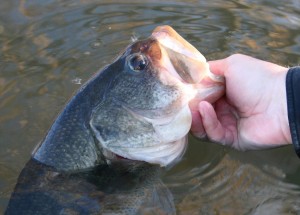 where Florida- and northern-strain largemouths native to Tennessee overlap; average annual water temperature is the feature that identifies that zone. Other factors TWRA considered when deciding where to stock Florida bass included: the presence of ideal habitat and abundant aquatic vegetation, productive shad populations as forage and acceptance by a trophy-management-minded angling public, which equates to a higher commitment to catch and release. After several years and some adjustments to the stocking-program, TWRA testing in 2013 confirmed the Florida-strain genes present in Lake Chickamauga had increased to about 45% and by then there was no question stocking had increased the number of larger bass in the population. The lake has become such a dynamic fishery for largemouth bass that in Bassmaster Magazine’s list of Top 100 bass lakes for 2014, Chickamauga ranked 7th best in the country. Furthermore, yesterday I stumbled across an announcement while doing further research that the Tennessee state record for largemouth bass has now officially been broken. On February 13th, Gabe Keen landed a 15.2-pound largemouth from Lake Chickamauga that smashed the long-standing record by more than half a pound. I’m not surprised the monster bass was caught during the cold-water period in mid-February. If you enjoy fishing for big bass, or have aspirations of catching the trophy largemouth of your dreams, you too should be fishing for them during the cold-water period. A trip to Chickamauga has already been added to my bucket-list of largemouth bass fishing destinations for next fall and winter.
where Florida- and northern-strain largemouths native to Tennessee overlap; average annual water temperature is the feature that identifies that zone. Other factors TWRA considered when deciding where to stock Florida bass included: the presence of ideal habitat and abundant aquatic vegetation, productive shad populations as forage and acceptance by a trophy-management-minded angling public, which equates to a higher commitment to catch and release. After several years and some adjustments to the stocking-program, TWRA testing in 2013 confirmed the Florida-strain genes present in Lake Chickamauga had increased to about 45% and by then there was no question stocking had increased the number of larger bass in the population. The lake has become such a dynamic fishery for largemouth bass that in Bassmaster Magazine’s list of Top 100 bass lakes for 2014, Chickamauga ranked 7th best in the country. Furthermore, yesterday I stumbled across an announcement while doing further research that the Tennessee state record for largemouth bass has now officially been broken. On February 13th, Gabe Keen landed a 15.2-pound largemouth from Lake Chickamauga that smashed the long-standing record by more than half a pound. I’m not surprised the monster bass was caught during the cold-water period in mid-February. If you enjoy fishing for big bass, or have aspirations of catching the trophy largemouth of your dreams, you too should be fishing for them during the cold-water period. A trip to Chickamauga has already been added to my bucket-list of largemouth bass fishing destinations for next fall and winter.
Though noteworthy, my fishing adventures this winter have not been limited to the pursuit of largemouth bass because I’ve enjoyed some good river fishing for big smallmouths. The Holston River where I fish has had lower than normal flow this year because of reduced water generation upstream at Boone Lake Dam. Nonetheless, the smallmouths are still in the river so adjustments to the reduced current have produced some beautiful fish. Throughout the cold-water period, I prefer fishing in rivers for smallmouth bass when water flow is highest because it concentrates fish in eddies, often close against the shoreline. When river bass are pushed into places with reduced current, they’re easier to find and catch rates are higher when the correct lures and methods of presentations are employed. In low current, fish scatter, so it’s more difficult to find and catch them. Most 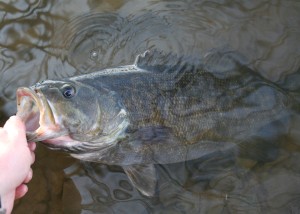 times when fish are scattered, it’s best to use high-speed search baits to find them. However, the best way to find and catch smallmouths during winter in a cold river with reduced flow is to use a slow-and-steady horizontal retrieve, a method of presentation that requires discipline and patience. I’ve learned that small, slim-profile swimbaits make excellent search baits in cold-water rivers but using the correct retrieve speed is crucial to success. A variety of swimbait brands work well but those in three-and-a-half to four-inch lengths work best. Vary lure color based on water clarity, depth and light penetration. Less-visible, natural colors draw more strikes on sunnier days in clear water so smoke- or clear-colored bellies with some flashy metal-flake and green or brown backs are top choices. Brighter colors are more visible to fish and draw strikes under overcast skies or in stained water. Even so, with the best color, a tight line and slow, steady retrieve strikes are often difficult to detect. Many times there will be a light tap when fish strike, often engulfing the lure from the rear, but it’s equally common for the line to gradually become heavy from the fish’s weight. It takes practice to tell the difference between a clump of weeds and a strike so when in doubt, set the hook until you develop a feel for a river smallmouth grabbing a swimbait in cold water.
times when fish are scattered, it’s best to use high-speed search baits to find them. However, the best way to find and catch smallmouths during winter in a cold river with reduced flow is to use a slow-and-steady horizontal retrieve, a method of presentation that requires discipline and patience. I’ve learned that small, slim-profile swimbaits make excellent search baits in cold-water rivers but using the correct retrieve speed is crucial to success. A variety of swimbait brands work well but those in three-and-a-half to four-inch lengths work best. Vary lure color based on water clarity, depth and light penetration. Less-visible, natural colors draw more strikes on sunnier days in clear water so smoke- or clear-colored bellies with some flashy metal-flake and green or brown backs are top choices. Brighter colors are more visible to fish and draw strikes under overcast skies or in stained water. Even so, with the best color, a tight line and slow, steady retrieve strikes are often difficult to detect. Many times there will be a light tap when fish strike, often engulfing the lure from the rear, but it’s equally common for the line to gradually become heavy from the fish’s weight. It takes practice to tell the difference between a clump of weeds and a strike so when in doubt, set the hook until you develop a feel for a river smallmouth grabbing a swimbait in cold water.
Trout fishing is another top choice during winter because trout are a cold-water species and active in lower temperatures, more than other game fish in southern waters. During brief warm-ups I may slip away to fish for bass but during the cold-water period, I fish most for trout. Furthermore, it’s a good time to catch big fish because browns spawn from late-fall through early-winter and larger spawners are active. Rainbows spawn in early spring so they are at peak bodyweight during winter and many become beautifully colored as the spawning period approaches. Similar to river smallmouths, some adjustment in lure selection and presentation will reward you with some of these beautiful salmonoids. As with any game fish, water temperature below a trout’s preferred range slows its metabolism so slower presentations are often best. Trout become less willing to move far to strike lures in lower temperatures so repeated casts or trolling passes are often necessary to make fish strike. Therefore, midwinter trout fishing is often a lower-numbers game but the possibility of catching larger fish can offset the decline in 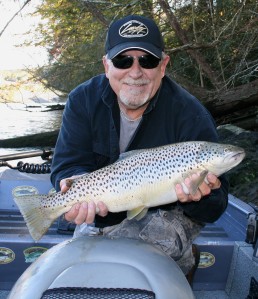 numbers. Lure selection during winter in the waters I fish is simplified because of shad die-offs. During the coldest period of winter, generation below dams spews dead and dying shad pulled through intakes into the tail-waters below. Trout, stripers, catfish and other predators become so focused on this regenerating supply of easy-to-catch food they may ignore other food sources. Take a close look at shad or alewives you see floating along the surface below dams you fish and it will simplify lure selection because choosing the correct lure size is often more important than color. Color and flash draw attention and determine visibility at distance; lure size sells the offering. All three are important when dialing in the best choice in lures but most times lure size trumps the other two.
numbers. Lure selection during winter in the waters I fish is simplified because of shad die-offs. During the coldest period of winter, generation below dams spews dead and dying shad pulled through intakes into the tail-waters below. Trout, stripers, catfish and other predators become so focused on this regenerating supply of easy-to-catch food they may ignore other food sources. Take a close look at shad or alewives you see floating along the surface below dams you fish and it will simplify lure selection because choosing the correct lure size is often more important than color. Color and flash draw attention and determine visibility at distance; lure size sells the offering. All three are important when dialing in the best choice in lures but most times lure size trumps the other two.
Though I’ve also fished less for trout this winter, I took one special trip to fish for them that was most memorable. My good friend John Flanagan called one dark, wintery day and asked if I’d like to join him for an afternoon of fly-fishing for trout on one of his favorite streams. I had never fly-fished but eagerly accepted the invitation. I met John at a book-signing event in Abingdon, VA last summer and we quickly became good friends. John is a highly skilled angler and serious fly-fishing enthusiast whose credentials include appearances on my friend Curtis Fleming’s television show, Fly Rod Chronicles. So I couldn’t have been more honored to join him and receive some hands-on training from such a talented fly-fisher. We scheduled our trip on a day when the air temperature was forecast to bump fifty-degrees, set a time and place to meet and our adventure was set.
When we arrived at the stream, the water was high and stained but our enthusiasm was little affected. John chose flies he believed would produce fish and rigged our fly rods for battle. For the rookie, John set up the fly-fishing equivalent of a bobber and nightcrawler; a float called a Thingamabobber and a fly that looked like a tiny garden redworm called a San Juan Worm on a 3x tippet, known among the uninitiated as eight-pound test line. After an extended but patient class that armed me with a clumsy roll cast and traditional delivery, serious fishing and further casting practice began. I was all thumbs when casting but was very familiar with the quarry, comfortable fishing a small stream and experienced when selecting spots that should hold trout. And the mental image of casting a bobber and nightcrawler increased my confidence. Soon I was attracting strikes and follows from hungry rainbows and in little time landed my first trout. I was most impressed with the battle on that long, limber rod and John had the drag set perfectly on the reel. I gained the greatest confidence in my tackle after hooking and landing a beautiful four-pound rainbow. The big fish charged downstream to the far end of the pool like a torpedo but with patience, I had little trouble working her back upstream to the net. By the end of the afternoon I had proudly landed five nice rainbows, though I’m sure it was not a graceful thing to watch. So I enjoyed my first fly-fishing trip immensely though I expect it may be a long time before Curtis Fleming asks me to be a guest on his show. However, I hope John invites me back soon for more casting practice and great stream-fishing for rainbow trout.
If you’re setting at home wishing for an early spring so you can go fishing, you’re missing some good fishing now. Bass, channel catfish, walleyes, crappie and others are grouped together in high numbers this time of year and offer exceptional fishing after you find them. If you prefer fishing streams and rivers, trout and smallmouth bass await. And there are few periods during the year when your chances of catching a trophy are better. If you need help getting started, pick up a copy of my book, The Weekend Angler’s Guide To Good Fishing and you’ll find the information needed to help you catch big fish throughout the cold-water period.
Be safe and good fishing!
The Summer Transition to Fall Fishing
It’s been a hot, beautiful summer across much of the south. Temperatures ran above average with rainfall well below; ideal weather for most outdoor activities. Limited rain early in the season baked my lawn, reduced mowing time and provided more free time for fishing but that’s where the good news ended. 2014 was one of the toughest years for summer fishing I can remember. Lack of rain held water generation rates down on the upper-TVA system and free-flowing rivers became crystal clear and shallow, encouraging dense aquatic weed growth. Both provided good conditions for anglers who wade and fish for trout, smallmouth bass and others, but created impassable conditions in most places for those with jet-drive outboards. Several trips to check various sections of my favorite smallmouth river produced disappointing results. When we caught respectable numbers of fish the average size was below normal, partly because we were limited on where we could fish. The river sections that normally produce our largest smallmouth bass of the season were inaccessible this year by jet-drive because of reduced flow and heavy weed growth. Even my favorite section of big carp water was so filled with weeds it was unfishable. This was the summer I wished I owned a Kayak. Night-fishing on reservoirs for smallmouth bass was equally challenging. Local highland reservoirs eventually reached full pool but hot weather drove surface water temperatures to well above normal. We adjusted and fished deeper to catch many bass but our catch rate of big fish, those pushing or above four pounds, was less than normal. So when September brought the first cool night air, falling surface water temperatures and increased generation to drop reservoirs to winter pool, I was eager to find improved fishing and some larger fish.
Soon after water generation increased, tail-water fishing began to improve. The flow of cooler water drew fish into shallow, fast water and on our first trip to check my favorite local tail-water we caught a nine-pound hybrid and several trout. On our second trip, on our first drift in the fast water, a big brown trout smashed my minnow lure so hard it almost jerked the rod from my hand. I looked back in time to see the angry fish clear 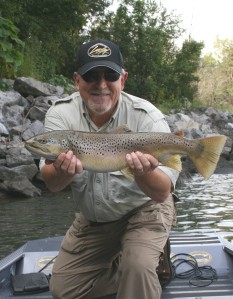 the water by two-feet and the battle was on. It was one of the hardest fighting browns I can remember with multiple water-clearing cartwheels and line-stripping runs. When we finally netted the twenty-five-inch-plus beauty I was trembling like a shy teenager on a first date. Fishing improved so quickly, I talked my wife Tammie into making a short trip after work one evening to try catching some fast-water trout. True to her reputation, she soon caught a beautiful male rainbow, as if it were no big deal. If you’ve not read my book, there’s a story in the last chapter that recounts how Tammie learned to fish and eventually earned the nickname, “Big Fish Woman”, emphasis on “Fish”, not “Big” as she always explains. Our success in that tail-water soon had me wondering when the exciting fall topwater fishing on area lakes would begin so I decided to visit a favorite reservoir and begin the search under the next major moon phase. My goal was to find some surface-schooling striped bass or hybrids.
the water by two-feet and the battle was on. It was one of the hardest fighting browns I can remember with multiple water-clearing cartwheels and line-stripping runs. When we finally netted the twenty-five-inch-plus beauty I was trembling like a shy teenager on a first date. Fishing improved so quickly, I talked my wife Tammie into making a short trip after work one evening to try catching some fast-water trout. True to her reputation, she soon caught a beautiful male rainbow, as if it were no big deal. If you’ve not read my book, there’s a story in the last chapter that recounts how Tammie learned to fish and eventually earned the nickname, “Big Fish Woman”, emphasis on “Fish”, not “Big” as she always explains. Our success in that tail-water soon had me wondering when the exciting fall topwater fishing on area lakes would begin so I decided to visit a favorite reservoir and begin the search under the next major moon phase. My goal was to find some surface-schooling striped bass or hybrids.
A week later, on a mild, partly cloudy afternoon two days after a new moon, a friend and I launched his boat in the headwaters of a local reservoir. Surface water temperature at the ramp was in the low-seventies; not as low as we had hoped but close enough I thought we might find some surface feeding black bass or hybrids. We ran down the narrow lake arm until we found a broad, open section with a large cove, a place that should attract some shad and schooling predators. As we idled across open water, the depth finder showed clouds of baitfish close to the surface and an impressive concentration of larger fish below them. There was no question this area was going to provide some good fishing when the feeding blitz began. However, the temperature had increased since we’d left the ramp. In my experience, the best surface feeding action in fall begins as the water temperature falls through seventy degrees into the mid- and upper-sixties. We sat and watched for breaking fish for more than thirty minutes and covered one point with casts where we saw some smaller fish feeding. But soon we decided to move on. Further down lake the temperature increased further and though we found many schools of baitfish dimpling the surface, they were very small and the larger fish we expected to see below them were absent. It was time to change strategies.
After discussing our options, we decided to move back up the lake into the headwaters to a place where my friend and his wife had seen surface schooling shad the previous week and we had found some striped bass during late-summer last year. It was shallow and hazardous, more river-like than lake, but the shad were still there and my confidence increased when I noticed the water temperature had dropped below seventy degrees. So we slowed and moved ahead, though the waning daylight was beginning to make navigation even more hazardous. Soon, it became so shallow we turned off the big motor and cautiously moved forward with the trolling motor. We decided to continue as far as depth would allow, then cast our way back out toward deeper water. By the time darkness fell, we were in water less than three-feet deep in a river little more than two casts wide so we slowed the trolling motor to a crawl, grabbed our rods and prepared to start casting. My friend grabbed a long spinning combo rigged with a five-and-a-half-inch Storm Jointed ThunderStick and I a heavy baitcasting combo with a seven-inch Cordell Red Fin. If there were stripers or hybrids present, one of these lures retrieved slowly along the surface should elicit a response. Expectations were high when we made our first casts but we didn’t expect what was about to happen.
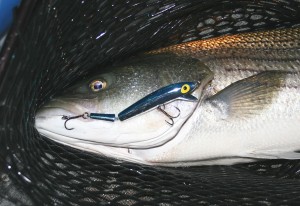 Several casts into our adventure, the water exploded under my friends ThunderStick and “Fish on!” echoed through the darkness. But after a brief, thorough thrashing of the water, the big fish pulled free. Two casts later, a big boil rose beneath my Red Fin, but the fish didn’t touch the lure. Whether they were stripers or hybrids, I knew they could be very size-selective and quickly exchanged my baitcaster for a heavy spinning combo loaded with the same Storm ThunderStick. In minutes my rod bent under the weight of a fish, a small striper between three and four pounds. Soon after my friend landed another; a hybrid between five and six pounds. In the next few hours, the topwater action we experienced was nothing short of incredible and the stripers got larger as the night progressed. We moved slowly upstream and later learned we were in the last hundred yards or so of water deep enough to float the boat, or hold fish. So when we finally reached the farthest point, we turned the trolling motor off and quietly drifted back downstream. Several times, large wakes streaked across the shallows in the dim starlight and we could see baitfish leaping clear of the water to escape. We had several more hits and misses but landed four striped bass between eleven and eighteen pounds. The most impressive event of the evening occurred around midnight while drifting silently downstream. We cast simultaneously toward the far shoreline and our lures landed not more than thirty-feet apart. After a short retrieve, both lures exploded as if on timers. We’d already caught several good stripers but quickly realized these must be older relatives, perhaps grandparents. My fish turned and headed down the river so fast I had no time to react. In seconds, it stripped off thirty feet of line as if my reel had no drag and then pulled free. My partner’s fish decided it wanted to play first. After a few energetic wallows, short screaming runs and an explosion or two, the giant simply spit the lure back at him at boat side. That’s little exaggeration because there wasn’t much left of the hooks on the plug; just fragments of twisted metal. And the split ring mounting loop on the front of the plug was bent at a forty-five degree angle. I was surprised the split rings weren’t straightened and gone. It was an impressive display of power by two huge striped bass.
Several casts into our adventure, the water exploded under my friends ThunderStick and “Fish on!” echoed through the darkness. But after a brief, thorough thrashing of the water, the big fish pulled free. Two casts later, a big boil rose beneath my Red Fin, but the fish didn’t touch the lure. Whether they were stripers or hybrids, I knew they could be very size-selective and quickly exchanged my baitcaster for a heavy spinning combo loaded with the same Storm ThunderStick. In minutes my rod bent under the weight of a fish, a small striper between three and four pounds. Soon after my friend landed another; a hybrid between five and six pounds. In the next few hours, the topwater action we experienced was nothing short of incredible and the stripers got larger as the night progressed. We moved slowly upstream and later learned we were in the last hundred yards or so of water deep enough to float the boat, or hold fish. So when we finally reached the farthest point, we turned the trolling motor off and quietly drifted back downstream. Several times, large wakes streaked across the shallows in the dim starlight and we could see baitfish leaping clear of the water to escape. We had several more hits and misses but landed four striped bass between eleven and eighteen pounds. The most impressive event of the evening occurred around midnight while drifting silently downstream. We cast simultaneously toward the far shoreline and our lures landed not more than thirty-feet apart. After a short retrieve, both lures exploded as if on timers. We’d already caught several good stripers but quickly realized these must be older relatives, perhaps grandparents. My fish turned and headed down the river so fast I had no time to react. In seconds, it stripped off thirty feet of line as if my reel had no drag and then pulled free. My partner’s fish decided it wanted to play first. After a few energetic wallows, short screaming runs and an explosion or two, the giant simply spit the lure back at him at boat side. That’s little exaggeration because there wasn’t much left of the hooks on the plug; just fragments of twisted metal. And the split ring mounting loop on the front of the plug was bent at a forty-five degree angle. I was surprised the split rings weren’t straightened and gone. It was an impressive display of power by two huge striped bass.
Several nights later, we returned for a rematch. This time we brought two boats; my friend with his wife, and I in my boat with frequent fishing partner Andy Barnes. Both our passengers had limited experience fishing for striped bass but were about to be fully initiated. In the next several hours, we collectively boated thirteen stripers up to fifteen pounds. I had another mid-teen fish pull free at boat side while Andy stood ready to net it. I waved it off as a victory because the fish had fought to near exhaustion. After quickly checking the hooks for damage, the topwater minnow again sailed into the darkness; no time to pout over a lost fish when the next cast might produce another. We all had more blowups and a few fish were lost but it was one of the most memorable trips I’ve had fishing for striped bass. This trip was made most special because we introduced newcomers to the exciting topwater fishing these powerful game fish offer. And the occasional shrill screams of a female voice echoing through the darkness made me chuckle every time. Later, as our companions drifted by us to leave, my friend’s wife started describing all the things she’d experienced. Her dialog began before we could hear her well, continued as fast as she could talk while they drifted slowly by, and finally dimmed into a series of high-pitched notes as they disappeared into the darkness. It was hilarious to hear that level of excitement in a grown woman’s voice. I was happy for her and proud of what she had achieved.
Many days of rain and high winds kept us from returning to our newly found striper honey-hole though we were impatient for one last visit before draw down of the lake erased the possibility. I was also concerned the cooling weather would drop the water temperature low enough the stripers would disperse back into the lake. So one calm, overcast evening when Andy called and said he could spring free for a few hours, we scrambled to pack the boat and leave for the lake. What we found was disappointing. The lake had already dropped so low that our previous fishing area was no  longer accessible. After repeated attempts to find a channel deep enough to reach our hotspot, we decided to start fishing as far upstream as possible and fish what we could. We had a few boils on our topwater minnows but landed only two stripers. But to end on a high note, Andy caught his largest striped bass ever; a long, slender fish that pulled the scales to more than twenty pounds. To reinforce his memory of these powerful fish, he hooked another not long before we had to leave. It was another giant that easily ripped line from his reel as it streaked toward the main lake, then pulled free. It was an impressive way to end a late-summer encounter with one of our most powerful freshwater game fish.
longer accessible. After repeated attempts to find a channel deep enough to reach our hotspot, we decided to start fishing as far upstream as possible and fish what we could. We had a few boils on our topwater minnows but landed only two stripers. But to end on a high note, Andy caught his largest striped bass ever; a long, slender fish that pulled the scales to more than twenty pounds. To reinforce his memory of these powerful fish, he hooked another not long before we had to leave. It was another giant that easily ripped line from his reel as it streaked toward the main lake, then pulled free. It was an impressive way to end a late-summer encounter with one of our most powerful freshwater game fish.
So my focus has again returned to the great fall fishing that is about to occur on reservoirs across the south. It’s time to renew the search for surface feeding stripers, hybrids and black bass. And very soon, shallow water fishing for largemouth bass will rival the great fishing of spring, minus the heavy fishing pressure and recreational traffic. However, I’m sure it will be some time before our thoughts and conversations drift away from the incredible striped bass fishing we experienced as summer passed to early fall. If you’d like to learn more about finding and catching striped bass in small rivers throughout summer, refer to the “Hunting for Trophies” chapter in my book, The Weekend Angler’s Guide To Good Fishing. And if you need help finding some great fall fishing on your home waters, the information you need to get started is there as well. Be safe, have fun and great fall fishing!
